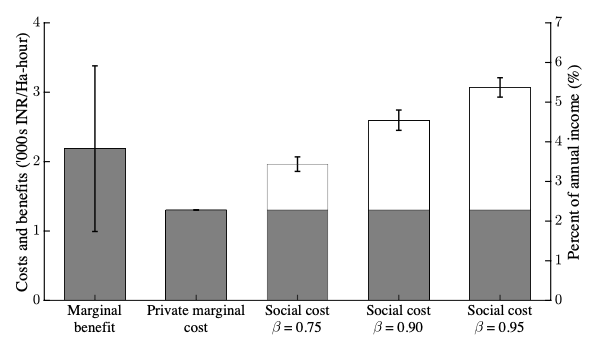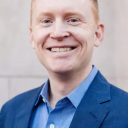
Rationing electricity supply limits farmers’ water use to a nearly efficient level on average, but also lowers agricultural productivity
Economic development consumes natural capital like forests, fisheries, water, and clean air. This depletion is usually not accounted for when measuring a country’s growth. How does policy geared towards the use of common resources balance environmental depletion with economic growth?
The Indian groundwater ‘commons’ problem
India faces a stark example of this trade-off with respect to the groundwater commons. An ever-growing number of farmers have taken up groundwater irrigation. Access to cheap water using electric pumps has allowed farmers in many areas to crop much more intensively, combining better seeds with more water to increase their yields and profits (Chakravarti 1973, Murgai 1999, Murgai et al. 2001). This intensification of agriculture has been a boon to farmers’ livelihoods, but is rapidly depleting groundwater reserves. Over the last decade or more, groundwater levels have declined faster in Northwestern India and Pakistan than in any other part of the world (Famiglietti 2014). The rate of groundwater use in large parts of India is far beyond sustainable levels (Figure 1).
Figure 1 Groundwater depletion in India

Note: The figure shows the rate of groundwater exploitation by district, as classified by the Central Groundwater Board, Government of India.
The story of poverty reduction in India has therefore been written in part through the depletion of the groundwater commons. As the water table declines, it becomes more and more difficult for farmers to get water to the surface. There is a real chance that continued groundwater depletion will throw agricultural progress into reverse.
Rationing is the de facto groundwater policy for the world’s largest user
The consensus on current groundwater policy is that it has wildly exacerbated the groundwater commons problem (Kumar and Singh 2001, Shah et al. 2012, Famiglietti 2014, Zhang 2019). According to textbook economics, the price of power to farmers should be set equal to social cost, including both the cost of power supply and the opportunity cost of water depletion, which lowers the profits that farmers will earn in the future. Instead, most Indian states charge farmers little or nothing for the electricity they use to run their pumps. In 2018, agricultural power subsidies cost India US$14 billion, twice as much as current outlays for the PM Kisan scheme, the government’s flagship unconditional cash transfer programme for farmers. Since prices are so low, the argument goes, farmers must be using too much water.
In a recent paper (Ryan and Sudarshan 2020), we reconsider this common sense view of Indian groundwater policy. Our first observation is that the above logic has a flaw. While states offer farmers power at a low price, farmers cannot use as much as they like. Many states systematically ration power, by switching off the electricity grid for farmers during most of the day. The rationing regime has expanded massively in the last two decades. As of 2017, the states that ration in this way have a combined population of 585 million people (365 million in rural areas) and produce 65% of India’s agricultural output.1
Once we recognise that farmers are being rationed, it becomes less obvious that they must be using too much water. We ran a large agricultural household survey of over 4,000 farmers in various parts of Rajasthan. The results showed that the ration binds on power and therefore water use: an overwhelming majority of farmers reported 5-6 hours of usage every day, right up against the ration.
The ration limits water consumption to around the socially efficient level
When farmers are being rationed, we must look beyond prices to evaluate the efficiency of groundwater use: farmers may be using too little water, or too much, depending on how much water the ration allows. To judge the efficiency of the ration, we need to measure the marginal benefit to power use, or how much farmer profits would increase if a little more power, and therefore water, were provided.
The paper estimates this marginal return by using the tight link between power and water use. Since all farmers get the same ration, it is not possible to estimate the returns to an increase in the power ration directly. Instead, we use the fact that for a given ration of power, some farmers get more or less water, due to accidents of geology that make the water shallower or deeper in a given area. We compare farmer profits for those with shallower and deeper groundwater. We then translate this estimated return to water into a corresponding marginal benefit of additional power use.
We find that the degree of access to water is extremely valuable to farmers. A farmer with a well that is one standard deviation (=187 feet) deeper earns profits that are lower by 13,000 rupees in the dry season, a decline that equals 14% of mean household income, from all sources, for the whole year. This is more than twice the value of the Indian government’s 6,000-rupee cash transfer programme to farmers.
Figure 2 Marginal benefits and costs to increasing the electricity ration by one hour

Note: The figure shows the estimated marginal benefits and costs of increasing the electricity ration by one hour, estimated for our survey sample of farmers in Rajasthan, India.
Figure 2 translates this value of water into a marginal benefit of power use. The left-most bar shows our estimate that a one-hour increase in power supply increases farmer profits by 2,200 rupees per hectare (left-hand axis), which adds up to 4% of annual income for an average farmer (right-hand axis). The additional profits are nearly as large as the social cost of additional power and water use. The three right-hand bars in the figure show the social cost of one hour of power use, including both the cost of power (lower bar segment in grey) and the cost of water (top bar segment), for three different discount factors. The marginal benefits of power use are nearly as high as the marginal social cost, at a discount factor of 0.90 (which corresponds to an interest rate of 10% per year).
This comparison, to our great surprise, implies that on average, farmers in Rajasthan are not using too much water. If farmers were using far too much water, then the marginal return to additional water use would be low. Our large estimates of the marginal benefit of water use suggest that water use is roughly efficient, on average.
What about the water table falling so quickly? No part of our analysis implies that water use in the past has not been excessive. Ironically, rapid groundwater depletion in the past may have raised the marginal returns to water today, by reducing how much water farmers are able to extract. Had policy been tighter decades ago, perhaps Northwest India would not be where it is today. But policy is oriented towards the future, and today rationing limits water consumption.
Rationing lowers productivity in favour of a more equitable distribution of profits
The main problem with rationing is that all farmers get the same ration of power each day, regardless of whether they have a lot of land or a little, or whether they are productive or unproductive in turning water into agricultural produce. Rationing imposes equality, instead of allowing the most productive farmers to use more water, while discouraging inefficient power and water use.
A Pigouvian regime that sets the price of power at social cost would solve this problem. If power were priced higher instead of rationed, we find that the average level of water use would be similar, but more water would go to more productive farmers. This reallocation of inputs would help increase social surplus by 11,000 rupees per farmer in the dry season, or 12% of the mean level of household income for the whole year. There is a catch though. By our estimates, the ‘right’ price in Rajasthan would be higher than the price today by a factor of 13! At this price, while a minority of farmers would earn markedly higher profits, the vast majority of them would be worse off. Pigouvian pricing would therefore lead to a ‘one percent’ problem: more economic output, but also dramatically higher inequality in profits.
Our estimates suggest that it would be hard for the state to unwind this increase in inequality just by refunding the revenue from higher power prices to farmers. While most farmers would be better off after such refunds, a significant minority, a quarter or more, would end up worse off. This number strikes us as large enough to make it politically hard to move away from rationing in one leap.
Can groundwater policy do better?
The picture of groundwater policy that emerges is much richer than the parable of cheap power leading to the exhaustion of natural capital. Rationing limits water use to around the efficient level, on average, but productivity and profits decline because water is not flowing to the most productive farmers. Even so, precisely because rationing benefits the least productive farmers, it is possible that the state might wish to use a ration, instead of a pricing regime, to prop up the poor.
Is there a third way, which combines the equity of a ration with the higher productivity of a pricing regime? The Indian government has recently released a draft Electricity Amendment Act that calls for Direct Benefit Transfers of Electricity subsidies (DBTE) to subsidised categories of consumers, including agricultural consumers. The DBTE idea has a lot of merit, and we think it may be able to thread the needle of improving efficiency without harming unproductive farmers.
The key is that a DBTE programme to replace present subsidies must be unconditional. Under an unconditional DBTE programme, electricity prices are increased to social cost, but farmers, at the same time, are compensated for this increase with a lump-sum entitlement, set equal to the value of the power (and water) they use today. Highly productive farmers can use more electricity, if it profits them, while poorer or less productive landholders can choose whether to use the full ration or cut back and keep more of their cash transfer. Farmers that save power and water will be left with cash in hand.
A concern over equity has arguably led to the wide adoption of the rationing regime we see in India today. The same concern, with an eye to economic efficiency, would justify paying farmers to leave water in the ground.
References
Chakravarti, A K (1973), “Green revolution in India”, Annals of the Association of American Geographers, 319-330.
Famiglietti, J S (2014), “The global groundwater crisis”, Nature Climate Change, 4(11): 945.
Kumar, M D and O P Singh (2001), “Market instruments for demand management in the face of scarcity and overuse of water in Gujarat, Western India”, Water Policy, 3(5): 387–403.
Murgai, R (1999), “The green revolution and the productivity paradox: evidence from the Indian Punjab”, The World Bank.
Murgai, R, M Ali and D Byerlee (2001), “Productivity growth and sustainability in post–green revolution agriculture: the case of the Indian and Pakistan Punjabs”, The World Bank Research Observer, 16(2): 199–218.
Ryan and Sudarshan (2020), “Rationing the Commons”, NBER Working Papers, No. 27473.
Shah, T, M Giordano and A Mukherji (2012), “Political economy of the energy-groundwater nexus in India: exploring issues and assessing policy options”, Hydrogeology Journal, 20(5): 995–1006.
Zhang, F (2019), “In the dark: how much do power sector distortions cost South Asia?", South Asia Development Forum, Washington, DC: World Bank.
Endnotes
1 States that ration power to farmers include Gujarat (which had a ration of 8 hours in 2017), Rajasthan (6 hours), Madhya Pradesh (9 hours), Maharashtra (9 hours), Punjab (5 hours), Andhra Pradesh (7 hours), Haryana (9 hours), Karnataka (6 hours) and Tamil Nadu (9 hours).


